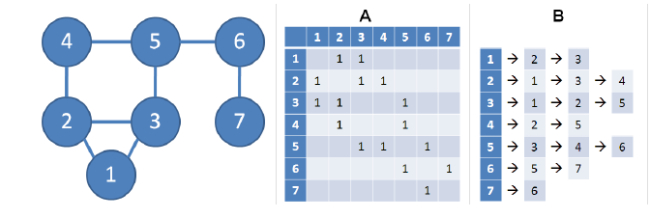A graph is a data structure that represent a collection of vertices and edges, that store connectivity information,
I will show how to represent a graph in 2 ways, and two graph traversal algorithms dfs, bfs. Finally i will add the snippets to load a graph, and dfs, bfs algorithms in c++.
You can get more theory information here: http://en.wikipedia.org/wiki/Graph_theory
Representation
A Adjacency matrix: Is a connectivity table represented in a 2D matrix int AdjMat[v][v]. For an unweighted graph we can set AdjMat[i][j] = 1 if there is connectivity otherwise the weigth.
B Adjacency List: Is a vector of vector of pairs. Here we store the information of the nodes in pairs. Neighbor and weight.
Graph Traversal
This is a video that explains in a clearly way two graph traversal algorithms, Deep First Search, Breadth First Search.
Snippets
BFS
#include <iostream> #include <cstdio> #include <vector> #include <queue> #define MAXN 500 using namespace std; vector < vector <int> > graph(MAXN); bool discovered[MAXN];//keeps track if a node has been reached int parent[MAXN];//stores the nodes ancestor that discovered it for the first time int distances[MAXN];//stores the distance to reach each node from the source void init_graph(int vertices) { int i; for(i = 0; i < vertices; i++) { discovered[i] = false; graph[i].clear(); distances[i] = parent[i] = -1; } } void read_graph(int edges) { int vertex1, vertex2; int i; for(i = 0; i < edges; i++) { scanf("%d %d", &vertex1, &vertex2); graph[vertex1].push_back(vertex2); graph[vertex2].push_back(vertex1); } } void bfs(int start) { int current;//current node being processed int next;//reached node by current unsigned int i; queue<int> vertices;//vertices to process distances[start] = 0; discovered[start] = true; vertices.push(start); while(!vertices.empty()) { current = vertices.front(); vertices.pop(); for(i = 0; i < graph[current].size(); i++)//for each node connected to current { next = graph[current][i]; if(!discovered[next])//if it hasn't been reached { discovered[next] = true;//mark it as reached parent[next] = current;//store its parent distances[next] = distances[current]+1;//save the distance vertices.push(next);//push it to the queue for further analysis } } } } void find_path(int vertex)//recursive procedure to find the path { if(vertex == -1) return; find_path(parent[vertex]); printf("%d ", vertex); } int main() { int vertices; int edges; int start; int dest_path; int i; scanf("%d %d", &vertices, &edges); init_graph(vertices); read_graph(edges); scanf("%d", &start); bfs(start); for(i = 0; i < vertices; i++) printf("%d ",distances[i]); printf("\n"); scanf("%d", &dest_path); find_path(dest_path); return 0; }
DFS
#include <algorithm> #include <cstdio> #include <vector> using namespace std; typedef pair<int, int> ii; // In this chapter, we will frequently use these typedef vector<ii> vii; // three data type shortcuts. They may look cryptic typedef vector<int> vi; // but shortcuts are useful in competitive programming #define DFS_WHITE -1 // normal DFS, do not change this with other values (other than 0), because we usually use memset with conjunction with DFS_WHITE #define DFS_BLACK 1 vector<vii> AdjList; void printThis(char* message) { printf("==================================\n"); printf("%s\n", message); printf("==================================\n"); } vi dfs_num; // this variable has to be global, we cannot put it in recursion int numCC; void dfs(int u) { // DFS for normal usage: as graph traversal algorithm printf(" %d", u); // this vertex is visited dfs_num[u] = DFS_BLACK; // important step: we mark this vertex as visited for (int j = 0; j < (int)AdjList[u].size(); j++) { ii v = AdjList[u][j]; // v is a (neighbor, weight) pair if (dfs_num[v.first] == DFS_WHITE) // important check to avoid cycle dfs(v.first); // recursively visits unvisited neighbors v of vertex u } } int main() { int V, total_neighbors, id, weight; /* // Use the following input: // Graph in Figure 4.1 */ //freopen("in_01.txt", "r", stdin); scanf("%d", &V); AdjList.assign(V, vii()); // assign blank vectors of pair<int, int>s to AdjList for (int i = 0; i < V; i++) { scanf("%d", &total_neighbors); for (int j = 0; j < total_neighbors; j++) { scanf("%d %d", &id, &weight); AdjList[i].push_back(ii(id, weight)); } } printThis("Standard DFS Demo (the input graph must be UNDIRECTED)"); numCC = 0; dfs_num.assign(V, DFS_WHITE); // this sets all vertices' state to DFS_WHITE for (int i = 0; i < V; i++) // for each vertex i in [0..V-1] if (dfs_num[i] == DFS_WHITE) // if that vertex is not visited yet printf("Component %d:", ++numCC), dfs(i), printf("\n"); // 3 lines here! return 0; }


[…] Graph representation and graph traversal (fabhodev.wordpress.com) […]